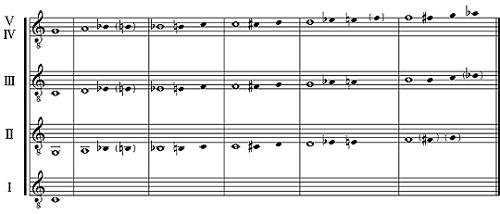| BIWA |
Biwa is a pear-shape musical instrument, has a curved backward neck,
some frets, and four strings. We play it with a larger plectrum
than one for Samisen. (Though the Biwa used in ensemble of us; Pro
Musica Nipponia has five strings, 4th string and 5th string are
tuned to the same tone and always played together. So to speak,
it is almost the same as four-strings one.)
[Tuning and the range of tone]
We often use the following tuning. Though we can chose other tunings,
the following one is very easy to play, and suitable for Biwa's
mechanism. It's impossible to change tuning in the middle of playing.
[Tuning]
The Biwa used in ensemble of us; Pro Musica Nipponia, has five frets.

We play a "whole note (not colored)" tone in above figure
with open string , or by pressing a string down between two frets.
Biwa's 1st string is often played in open string. Otherwise, we
play a "black-colored note" tone in above figure by more
strongly pressing it down. It is difficult to play jumping from
a "black-colored note" tone to a "black-colored note"
tone, because it takes a second to prepare to press a string down
strongly. We sometimes use multi-tones with open strings, but we
never use positions on two or much strings.
[Playing Techniques]
1.Sukui-----Picking a string up from the surface of body with a
plectrum.

2. "8"-----Circle Playing all strings in a single stroke
with a plectrum as we write "8" character.

3.Tremolo-----Tremolo is easy to play and very useful in music.

4.Arpeggio-----Sliding a plectrum from the top string (1st) to the
bottom string (5th).

5.Hataki / Uchibachi-----Playing strings, while striking the surface
of body with a plectrum.

6.Suri
(1)Scraping strings at right angle (vertically) with the bottom
of plectrum.

(2)Scraping strings parallel with the bottom of plectrum.
If we scrape from top to bottom of strings, it sounds from the lower
tone to the higher tone.

If we scrape from bottom to top of strings, it sounds from the higher
tone to the lower tone.

7.Osikomi (Oshikan) Pressing down a string for portamento.

8.Yuri Moving a finger on a string a little for vibrato after striking
it with a plectrum.

9.Glissando Moving a left-hands finger on a string quickly after
striking it with a plectrum.

10.Pizzicato Flipping a string with a right-hand finger without
a plectrum. (It's noted as "pizz.")
11.Hajiki Filliping a string with left-hand's fingers, without a
plectrum.

12.Uchi Tapping on a string with left-hand's fingers after striking
it with a plectrum.

|
|



